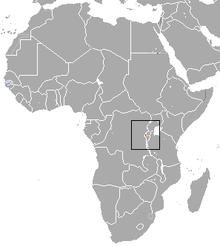| Rhinolophus hilli | |
|---|---|
| Conservation status | |
 Critically Endangered (IUCN 3.1) | |
| Scientific classification | |
| Domain: | Eukaryota |
| Kingdom: | Animalia |
| Phylum: | Chordata |
| Class: | Mammalia |
| Order: | Chiroptera |
| Family: | Rhinolophidae |
| Genus: | Rhinolophus |
| Species: | R. hilli |
| Binomial name | |
| Rhinolophus hilli Aellen, 1973 | |

| |
| Hill's horseshoe bat range | |
Rhinolophus hilli, Hill's horseshoe bat, is a species of bat in the family Rhinolophidae. It is endemic to Rwanda. Its natural habitats are subtropical or tropical moist montane forests, caves, and subterranean habitats (other than caves). In 2013, Bat Conservation International listed this species as one of the 35 species of its worldwide priority list of conservation. It is threatened by habitat loss.
Taxonomy
As the genus Rhinolophus is quite speciose, it is split into groups. Maclaud's horseshoe bat is the identifier of one of these groups, called the maclaudi group, which currently consists of six species, three of which were not described before 2003. Members of this group have large ears, and a diminished connection between the sella and lancet.
- Maclaud's horseshoe bat—R. maclaudi
- Rhinolophus willardi—discovered in 2013
- Ruwenzori horseshoe bat— R. ruwenzorii
- Hill's horseshoe bat—R. hilli
- Rhinolophus kahuzi—discovered in 2013
- Ziama horseshoe bat—R. ziama
R. maclaudi and R. ziama are considered the two West African taxa, while the other four species are found further east around the Albertine Rift. The West African species are larger in size than the East African species, with R. maclaudi as the largest bat of the species group. As these species are very similar morphologically, it was previously thought that R. hilli and R. ruwenzorii were the same taxon, and that the taxon was a subspecies of the Maclaud's horseshoe bat.
Conservation
The first two individuals of this species were encountered in 1964 and 1981. The locations of the two individuals were only 8 km (5 mi) apart. It is unknown where this species roosts during the day. The IUCN lists this species as critically endangered, due to a small range of occurrence of less than 100 km (39 sq mi), habitat destruction, a small number of subpopulations, and over-harvesting for bushmeat. In 2019, Hill's horseshoe bat was documented again for the first time since 1981, when single individual was found in Nyungwe National Park in Rwanda. Its calls were recorded, and the species has since been acoustically identified at eight other sites in the area.
References
- ^ Webala, P.; Flanders, J.; Frick, W.F.; Fahr, J. (2021). "Rhinolophus hilli". IUCN Red List of Threatened Species. 2021: e.T44781A203829053. doi:10.2305/IUCN.UK.2021-3.RLTS.T44781A203829053.en. Retrieved 17 December 2023.
- "Annual Report 2013-2014" (PDF). batcon.org. Bat Conservation International. August 2014. Archived from the original (PDF) on July 7, 2017. Retrieved May 1, 2017.
- ^ Peterhans, J. C. K., Fahr, J., Huhndorf, M. H., Kaleme, P., Plumptre, A. J., Marks, B. D., & Kizungu, R. (2013). Bats (Chiroptera) from the Albertine Rift, eastern Democratic Republic of Congo, with the description of two new species of the Rhinolophus maclaudi group. Bonn Zool Bull, 62, 186-202.
- ^ Fahr, J., Vierhaus, H., Hutterer, R., & Kock, D. (2002). A revision of the Rhinolophus maclaudi species group with the description of a new species from West Africa (Chiroptera: Rhinolophidae). Myotis, 40, 95-126.
- Smith, J. D., & Hood, C. S. (1980). Additional material of Rhinolophus ruwenzorii Hill, 1942, with comments on its natural history and taxonomic status. In Proceedings of the Fifth International Bat Research Conference,(eds. DE Wilson & AL Gardner) (pp. 163-171).
- "CONSERVATIONISTS ANNOUNCE THE REDISCOVERY OF AN AFRICAN BAT SPECIES LOST FOR 40 YEARS". Bat Conservation International. 8 March 2022. Retrieved 8 March 2022.
| Taxon identifiers | |
|---|---|
| Rhinolophus hilli | |